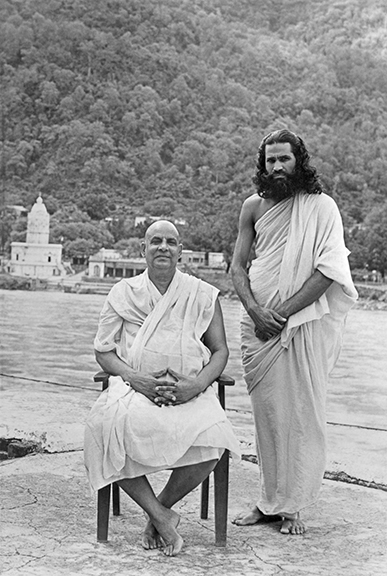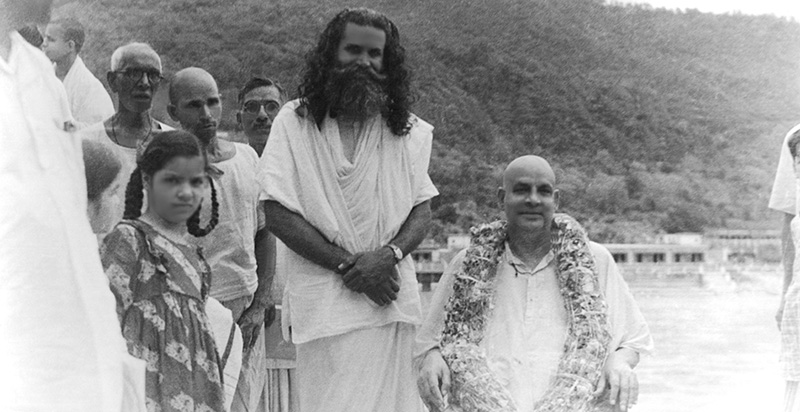 Sambasiva Chaitanya’s pilgrimage resumed. In the spring of 1949 he was able to continue on his way north to Rishikesh to the ashram of H. H. Sri Swami Sivananda, who was to become his Gurudev, his spiritual master.
Sambasiva Chaitanya’s pilgrimage resumed. In the spring of 1949 he was able to continue on his way north to Rishikesh to the ashram of H. H. Sri Swami Sivananda, who was to become his Gurudev, his spiritual master.
Sri Swami Sivanandaji Maharaj was a true saint. He lived until 1963, serving all humanity regardless of religion, race, color, caste or creed. He was often called Jagatguru (the great world Guru). Rarely traveling outside India, he managed to send his spiritual vibration to almost every comer of the globe. Thousands of people came to know about the great science of Yoga through his hundreds of books. Many of his disciples are now revered teachers themselves. Born in the small South Indian village of Pattamadai near Tirunelveli on the 8th of September, 1887, he apparently possessed an inborn passion for serving others. This manifested at first in his desire to be a physician. After he received his medical degree, Dr. Kuppuswamy (as he was then called) served in Malaysia for several years. During his days of medical practice he never concerned himself about the amounts of fees or the ability of his patients to pay him. Sometimes he went from door to door, serving the poor. His practice was open day and night. “To serve people and to share what I have is my inborn nature,” he said. The aspiration to completely renounce any ties to prestige or position caused him to leave Malaysia at the height of his medical career and return to India to live a monastic life.
In 1936, with the help of a few devotees, he founded the Divine Life Society in Rishikesh. Master Sivananda chose this title because he didn’t want to name the new society for any particular religion or individual. To him divine life meant leading a healthy, happy, peaceful and spiritually prosperous life—something sought by people of all persuasions. Today the Divine Life Society has more than 400 international branches. In private, Master Sivanandaji’s students often referred to him as “Swami Givananda” because of his totally warm and generous nature. Whenever someone came to the ashram Master Sivanandaji would pile the guest up with free books. Sometimes a visitor would protest, “Swamiji, I came by plane and can’t carry all these books back in my luggage. The airline company will charge me for them.”
Beyond a doubt, Sambasivam knew that he had reached his final destination. All the other masters had prepared him for this stage. Master Sivanandaji was unquestionably the one by whose hand he would take the great step of sannyas (monastic) initiation at last. Prior to his initiation, Sambasivam served in the ashram conducting Hatha Yoga classes and answering correspondence in the Tamil language. Swami Sivanandaji would sort the mail, referring certain letters to ashramites who had a particular knowledge of the subject mentioned. Later Sambasivam gave Raja Yoga lectures at the Yoga Vedanta Forest Academy.
July 10, 1949, the day of Sambasivam’s sannyas initiation was clear and warm. The Ganges sparkled with reflections. With his freshly shaved face and head, Sambasivam presented himself to his Guru. The Master looked at him silently. Sambasivam sat before the orange flames of the sacrificial fire as thousands of sannyasis had done before and thousands would do afterward. Into the fire the initiate symbolically offers the body, mind, intellect—in fact, all that could be called one’s own. The sannyasi feels that all worldly attachment is totally burned at that time, and from that day forward he or she walks forth as a shell, used only as an instrument of the Divine. Even the little tuft of hair is cut by the Master and tossed into the river. In the Holy Ganges River, a sannyas mantra is repeated for the first time. The devotee dips into the water three times and walks to the shore where the Guru awaits. There the sannyasi accepts the gerua cloth from the Master. Its color is orange, as if it came directly out of the sacrificial flames. After donning the bright new cloth, the sannyasi drops the last remaining article of old clothing into the river. Now the body, the mind, even the dress all belong to the Master.
If this shiny new instrument of the Divine is supposed to serve, the ones in need of service must have some way to call for it. There must be a new name. All are given the title Swami (master of one’s own self), and all the names end in ananda (supreme bliss) since a sannyasi is the most joyous of people. The one who had been called Sambasivam became Swami Satchidananda (Existence-Knowledge-Bliss Absolute). His fellow initiates were named Swami Chidananda (Knowledge-Bliss Absolute), Swami Mounananda (Bliss of Silence), and Swami Brahmananda (Bliss of Brahma).
The following morning business continued as usual. The new Swami Satchidananda waited in his Guru’s office to receive the daily load of correspondence. Master Sivanandaji entered and studied his new Swami curiously. “Satchidanandaji,” he said thoughtfully, “I’m giving you special permission to grow your hair again. You looked so beautiful that way. I want you to look like that again.” He did not cut it since.

Recent Comments